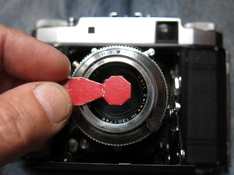I finally purchased a 3 sensor shutter meter. My leica/Minolta CL were pretty much the same at fast shutters.
This is what i found on all 3:
1000 is 600
500 is 400
250 is 250
125 is 110
+- 5%
I have maybe 25 more mechanical cameras to check
Are mechanical cameras all slow over 250?
My 3 Minolta CLE were +-5%
It's more useful to view the error is terms of f/stops using the formula:
log(actual/expected)/log 2
So, for example the 1/500 figure is off by -.32 f/stops - which isn't a big deal
After having measured dozens upon dozens of mechanical shutters, albeit it with a single sensor tester, I have yet to see one hit the top speeds with any real accuracy. HOWEVER, if the other speeds are OK (within 1/3 of a stop or so), I am reasonably sure this is mostly a measurement artifact.
But I think it's overkill to worry about it. Using a single sensor timer, a brand new Hasselblad lens will still show 1/3 to 1/2 stop slow at 1/500th. I just got a Hasselblad lens CLAed and everything measured within 0.2 stop or better but 1/500 was "off" 1/2 stop.
With large format leaf shutters, the effect is even more pronounced because you're trying to move a lot more mass. The older Ilex shutters had enough adjustments and mechanism in them that you could get both high and lower speeds reasonably close. But my newer Copals cannot hit max speed reliably at the fast settings. At least that's been my experience when comparing nearly new Copals against just-CLAed Ilex shutters.
For large format, this tends to be a non issue. It's worth noting that mechancial shutters read somewhat differently if you test them after having not been used for a while, vs. firing them a few times and then testing them.
In my view, this just isn't that important. It's largely measurement artifact at the higher speeds. Moreover, a slow shutter will give you slightly more exposure which is well within the latitude of most films and is generally far more desirable than underexposure. The one exception would be shooting 'chromes in which case I'd just bracket a half stop and call it a day.
At high speeds, the shutter is open longer in the center than at the edges. For slower speeds, this difference is negligible since it is very small compared to the overall time the shutter is open. But at higher speeds the difference between center and edge open time becomes an appreciable percentage of the short time the shutter is open.
There is probably some formal definition for speed that takes into account edge and center open times. It might even be some kind of integral formula that computes the total amount of light the film absorbs. But a sensor measuring open time in the middle of the aperture isn't going to take that into account. In theory, some of the multi-sensor measurement tools do, but I have no idea how they are taking into account center vs. edge speeds.
In any case, I think this is mostly not much of an issue in practice. Other than transparency films, modern emulsions have plenty of latitude and 1/2 stop or even 3/4 stop of actual error isn't really much of an issue.
It's worth noting that, for monochrome, that's why the whole idea of "Personal EI" came into being. You calibrate everything for your shutters, your meter, your exposure placement, your manner of agitation, your developer, and so on to come up with
your effective film speed. None of this contemplated 0.1 stop resolution (Beyond The Zone System notwithstanding).
Small Editoral Note: With the advent of digital displays and cheap measurement tools, there is a disturbing trend of folks becoming obsessed with absolute accuracy with everything they use. These old mechanical devices had a fair bit of tolerance when new, and will now have even more with decades of use behind them. Expecting electronic shutter accuracy is unrealistic.
I see this all the time when I use a laser to align my old Omega D-2. I can adjust it to be "right on", move the head to a new position, and now it's off a bit again. This old stuff wasn't designed for absolute perfection (whatever that might mean). Another good example of this is that people tend to trust digital numeric displays as being more correct than a moving needle analog indicator. This trust is sometimes misplaced.








